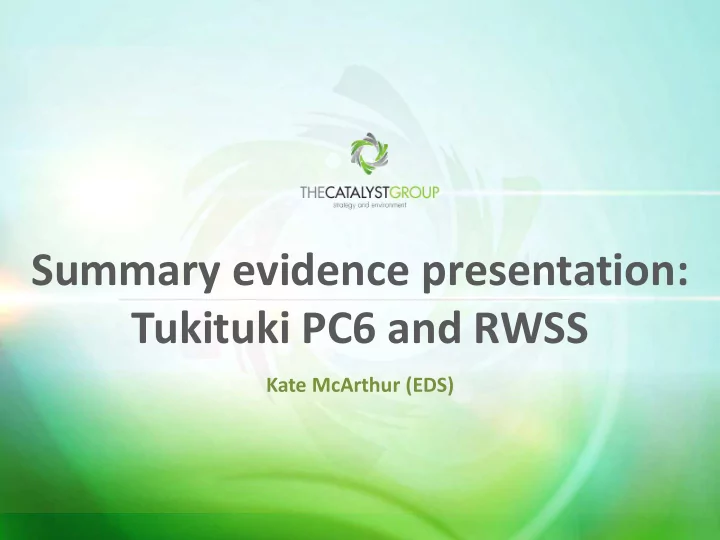

Summary evidence presentation: Tukituki PC6 and RWSS Kate McArthur (EDS)
Effects of excessive periphyton • No. and quality of ‘swimming days’ reduced by slime • No . and quality of ‘angling days’ reduced • River closure due to Phormidium sp. blooms • Passive use affected by reduced aesthetic appeal and/or odour • Dissolved oxygen reduction at night affects life- supporting capacity, extremes cause fish mortality • Few high quality macroinvertebrates (EPT taxa) – snails, worms and midge larvae instead • Lower growth and reproduction in fish
Pollution sensitive taxa: the “good guys”
Pollution tolerant taxa: the “bad guys”
Reducing periphyton effects • Effects on values reduced by decreasing duration and frequency of nuisance growth (i.e. more swimming and angling days, better ecological health through more stable dissolved oxygen and higher life-supporting capacity) • Meeting nutrient limits more often reduces frequency and duration of nuisance growth
80 mg/m 2 chlorophyll a: 20% cover
120 mg/m 2 chlorophyll a: 30% cover
160 mg/m 2 chlorophyll a: 40% cover
300 mg/m 2 chlorophyll a: 55% cover
900 mg/m 2 chlorophyll a: 70% cover
90% cover by green filamentous periphyton • Effects on recreational and ecological values
Risk management of nutrients • Reducing and controlling P is important to reduce the frequency and duration of excessive periphyton in the Tukituki catchment • Reducing and controlling N is also important • N concentrations contribute (with P) to the frequency and duration of periphyton blooms
Risk management of nutrients • Reliance on a single limiting-nutrient approach is less effective at reducing excessive periphyton • Reductions of P and N will further reduce the duration and frequency of nuisance periphyton growths across the catchment • Other effects and risks are also reduced through dual nutrient management
Potential effects of single nutrient management • Increased Phormidium sp. dominance of periphyton communities • Leads to increased probability of high-impact effects on safe contact recreation and amenity values e.g. river closure, dog deaths, public health • Ecological and aesthetic effects: reduction in macroinvertebrate health and odour issues
Periphyton is a multi-species assemblage
85% cover of benthic cyanobacteria ( Phormidium sp. ) • Effects on ecological values • River closed to recreational use
Potential effects of single nutrient management - estuary • Increased estuarine enrichment from N: nuisance macroalgae, anoxic sediment, loss of in-fauna • Mortality of estuarine in-fauna is an effect of low probability but high impact • Resulting effects on aesthetic and recreational values in the estuary are more likely e.g. odour issues
Risks… • Failure to effectively manage P: greater impacts if P management is slow, incomplete or fails in the presence of uncontrolled or elevated N • Failure to successfully reduce P from point sources is common. Catchment-wide reductions in diffuse P inputs are uncertain - increasing risk of ‘surprise’ ecological effects and implementation lags (Jarvie et al. 2013)
• Combined risks and potential effects require a cautious approach to nutrient management • Level of risk supports the requirement for an DIN limit/target in PC6 (Zones 1, 2, 3 and 5) to reduce the duration and frequency of nuisance periphyton • Contaminants directly related to aquatic health and safe contact recreational objectives (i.e. deposited sediment, MCI & water clarity) require control through PC6 as limits/targets
Outcomes • Remaining P neutral and allowing increased N is unlikely to achieve OBJ TT1(a), (b) or (c) • Positive periphyton outcomes are more likely through dual nutrient and contaminant management • Periphyton cover limits in 5.9.1B should utilise PeriWCC • Linking sediment, MCI and water clarity to OBJTT1(a) & (b) through limits/targets is preferable to provide certainty of outcomes
Water quantity and allocation • Combined adverse effects from increased allocation , continuation of takes below minimum flow (deep & stream depleting groundwater and takes for permanent root stock and spray contracting) • Increases in allocation (ground or surface water) require increases in minimum flow to compensate adverse effects on ecology • Increases in allocation or reduction in minimum flows are unlikely to meet OBJ TT1(a)
RWSS effects • Makaroro catchment: healthiest measured native fish & macroinvertebrate communities in TT • Permanent loss of aquatic habitat upstream of dam, including threatened species e.g. Northern dwarf galaxid, torrentfish, longfin eel, bluegill and redfin bullies • Significant adverse effects from altered flows 11km between dam & Waipawa confluence, flow alteration effects in upper Waipawa also • Catchment-wide adverse effects from intensification of land use within and downstream of irrigation command area
RWSS effects • Increases in nitrogen in combination with phosphorus neutral conditions unlikely to achieve OBJTT1(a), (b) or (c) • Mitigation of periphyton growth uncertain and only affects Waipawa and Tukituki mainstems – even if fully effective, flushing flows will not mitigate full area of effects • Diffuse P neutrality cannot be ‘offset’ by reduced WWTP discharges – ecological outcomes of upgrades uncertain, any benefits only apply to Waipawa and Tukituki mainstems downstream of SH2 • Consent requirements are an existing benefit
Photo acknowledgements • Slide 3: (Top to bottom) stonefly, caddis fly and mayfly larvae (EPT macroinvertebrates), the late Stephen Moore, courtesy of Landcare Research • Slide 4: (Top to bottom) Snail, oligocheate worm and chironomid midge larva, Stephen Moore, Landcare Research • Slides 6-10: Periphyton growth (biomass and %cover) Waipara River, courtesy of Barry Biggs (reproduced from the NZ Periphyton Guidelines) • Slide 11: Rangitikei River at Mangaweka 2009, Kate McArthur • Slide 12: Rangitikei River at Mangaweka 2008, Kate McArthur • Slide 16: Mangaone Stream, tributary of the Manawatu River at Palmerston North 2005, Kate McArthur • Slide 17: Manawatu at Hopelands, 2008, Kate McArthur
Recommend
More recommend